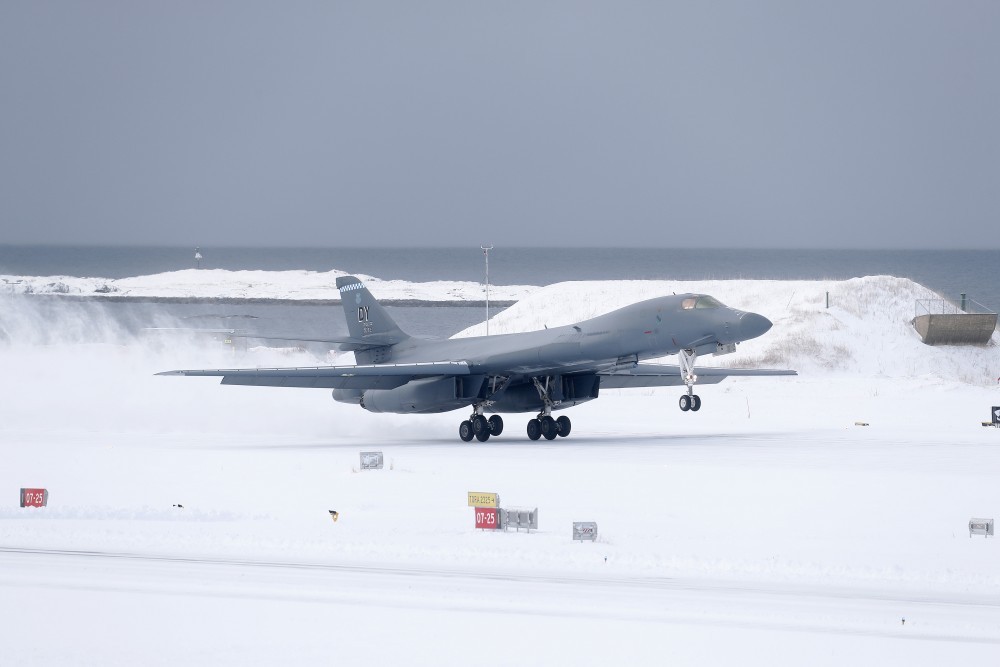U.S. B-1 bomber makes first landing inside Norway’s Arctic Circle

The short first-of-its-kind landing and refueling at Bodø Air Base was part of the training mission for the supersonic American bombers temporarily deployed to Norway.
Bodø Air Base just north of the Arctic Circle is home to Norway’s fleet of F-16 fighter jets, including NATO’s northernmost aircraft prepared for alert-scramble to meet Russian military planes flying out from the Kola Peninsula.
The B-1 that landed in Bodø on March 8 is one of four bombers currently deployed to Ørland Air Station in southern Norway. The bombers are mostly training together with the Norwegian Air Force, but joint flights have also taken place with Swedish fighter jets.
It was last autumn, the Ministry of Defense in Oslo got a call from the U.S. Air Force to send B-1B Lancer bombers for a first-time temporary deployment to Ørland Air Station for the period of February and March 2021.
“The Government has thoroughly considered the request and concluded that it will provide an opportunity for important cooperation and training and therefore welcomes it,” Defence Minister Frank Bakke-Jensen, said when the issue was debated in the Parliament in January.
Bakke-Jensen said the training will strengthen NATO’s ability to defend Norway.

Russian strategic bombers have since 2007 regularly been flying missions in international airspace outside northern Norway.
“We must expect some Russian reactions to the deployment,” Bakke-Jensen said.
“The B-1B are heavy capable bombers and Russia will claim the deployment increases tensions,” he added.
However, allied aircraft operating from airports in Norway do normally not conduct training activities east of the 24th meridian, a self-imposed restriction Norwegian authorities have set not to provoke Russia in the north.
Moscow unhappy
Russia’s dissatisfaction with the arrival of the American bombers to Norway became clear, as the Northern Fleet in late February announced missile shootings in an area between mainland Norway and the Arctic island of Bjørnøya (Bear Island).
The missile cruiser “Marshal Ustinov“ sailed to the area, but no missiles were launched.
“Given the timing and location of the Russian missile test, and the anticipated arrival of the U.S. B1 bombers, the missile exercise may well be intended to serve a signaling purpose,” said Senior Research Fellow at the Norwegian Defence Research Establishment (FFI), Kristian Åtland to the Barents Observer.
He said this could be Moscow’s way to communicate dissatisfaction with the temporary presence of U.S. bombers on Norwegian soil.
In the same mission, “Marshal Ustinov” sailed into the Varanger fjord and stayed outside Norwegian territorial waters near Grense Jakobselv, in a maneuver not seen before.
‘Enhancing regional stability’

The U.S. Air Force said in a statement the four B-1B bombers deployed to Ørland Air Base will conduct training missions across Europe.
“Training with allies like Norway enables us to hone our deterrence and defense capabilities while also enhancing regional stability,” said General Jeff Harrigian, Commander of U.S. Air Forces in Europe-Air Forces Africa.
Related stories from around the North:
Canada: Canada stresses need for cooperation at Arctic Frontiers conference, Radio Canada International
China: China, Russia singled out in new U.S. Arctic defense strategy, Eye on the Arctic
Denmark: Pompeo to talk Arctic at upcoming meeting with Danish Foreign Minister, Eye on the Arctic
Finland: Finland’s Defence Ministry blocked Chinese plans for research airbase in Lapland, Yle News
Iceland: Iceland welcomes “peaceful, low-tension cooperation” with China in Arctic, says foreign minister, Eye on the Arctic
Norway: Increase in NATO scrambled jets from Norway, The Independent Barents Observer
Russia: Threat of military conflict in the Arctic is ‘relatively low,’ says top Russian diplomat, Eye on the Arctic
Sweden: Sweden’s FM calls for more EU involvement in Arctic as country hosts EU Arctic Forum, Radio Sweden
United States: New U.S. Arctic strategy focuses on ‘day-to-day competition’ with Russia and China, Eye on the Arctic



